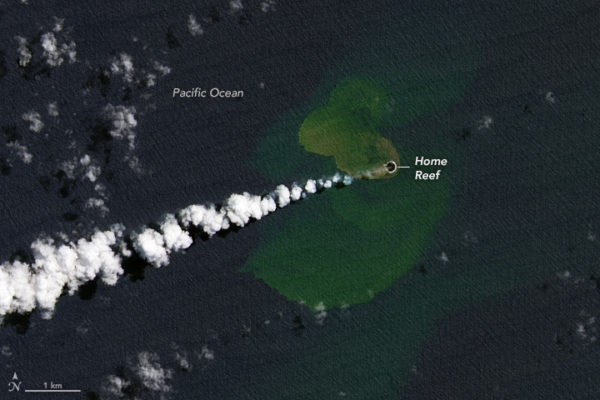Experts were concerned about a new island that emerged in the Pacific. Even though everyone is in awe of the little island, this kind of incident has happened in the region, and experts say it tends to be a bit of a flight risk.

New Island
An underwater volcanic explosion caused this new "island"-still without a name-to materialize. The isle in issue started on September 10 due to the active volcano situated on the Home Reef seamount, a group of sub-oceanic mountains that run along the ocean bottom between New Zealand and Tonga. Since then, it has expanded to around 8.6 acres or 6.5 specific football fields.
Ephemeral Islands
According to The Washington Post, the first known eruption of Home Reef took place in 1852 and left behind a temporary island mass. After five years, there was another eruption, which led to another ephemeral island. The exact sequence of eruptions-a volcano erupts, an "island" emerges, and then vanishes-was repeated in 1984 and 2006.
According to a NASA press release, undersea volcano-created islands "are frequently transient."
Unfortunately, these transient marine anomalies are not particularly structurally sound. Since they are primarily composed of ash and minerals, erosion quickly wears them down, so people can't even attempt to walk on them. And while some have persisted for up to 25 years, the majority only last for a few years, or sometimes even only a few months.
A temporary island appears, disappears due to erosion, and reappears over a brief period. Occasionally numerous times.
These transitory additions to the Earth aren't typical landmasses, which is weird to think about while considering an island. And if anything, the island with the newest volcano might serve as a reminder that the Earth is more than simply a piece of rock. It is still developing, altering, and increasing.
According to Tonga Geological Services geologist Rennie Vaiomounga, "it's more like a big coating of ash, steam, and pumice over the water." Referring to these unusual small isles as "geological [puzzles]," he added: "we never know when the [islands] will arise or when it will depart."
Flight Risk

A major worry is collisions between airplanes and volcanic ash clouds. Fine, abrasive volcanic ash, which may float in deadly proportions hundreds of miles downwind from an erupting volcano, can harm jet engines and other aircraft components.
Hundreds of volcanoes with the potential for dangerous explosive eruptions are located near or under the main air traffic routes of the world. Volcanic activity poses a substantial risk to aviation; every day, nearly 300,000 people and hundreds of millions of dollars worth of goods are transported by plane near active volcanoes in the United States alone.
In the past, many airplanes unintentionally collided with volcanic ash clouds, and jet engines have momentarily lost power in some instances. To lessen the probability of such encounters, a global group of government organizations (including the USGS, the Federal Aviation Administration, and the National Weather Service) now observe and monitor ash-producing volcanoes.
For more similar, don't forget to follow Nature World News!
© 2025 NatureWorldNews.com All rights reserved. Do not reproduce without permission.

